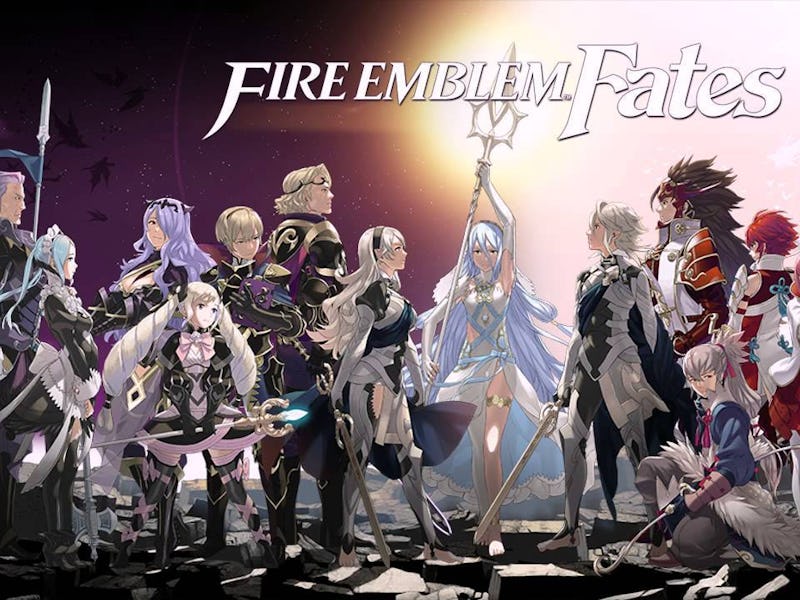How 'Fire Emblem Fates' Is Trying to Squander Its Goodwill
'Fire Emblem Awakening' was an instant classic. Its sequel -- 'Fire Emblem Fates' -- looks confusing and controversial.

Fire Emblem Awakening is probably the best game on Nintendo’s 3DS system. The 2013 game burst onto the scene, shattering conceptions of the Fire Emblem series being purely niche and lacking personality, and instead building a great game based on a combination of rough tactical combat, deep role-playing progression, and adorable anime romance.
The crucial, awesome thing about Awakening is this: Your party members will befriend each other and possibly fall in love with one another based on how much they fight with one another. This isn’t just cute (although it is), and it doesn’t just have their time-traveling babies show up later to join you (though they do do that, for sure). No, what makes this cool is that suddenly you, as a player, have a motivation for how to fight that’s not simply “win as easily as possible.” You want to move characters to the right places and attack in the right ways to both win and make as many friends as possible.
This was an astonishingly good idea, and instantly made Awakening a must-play for any gamer, not just hardcore RPG fans. Any sequel was naturally going to be widely-anticipated, and so publishers Nintendo and developers Intelligent Systems obviously made the best decision to make this year’s sequel Fire Emblem Fates as confusing as goddamn possible.
Fates has two kinds of problems hanging over its head as English-language release nears (February 19, to be exact). First, it’s confusing and expensive to figure out which form of Fates you actually want to buy. Second, its approach to translation, gender, and sexuality has been odd and controversial.
So what’s confusing about how to buy the game? Well, there isn’t a “the game,” for starters. Fates is divided into three games: Birthright, Conquest, and Revelation. But this isn’t a Pokémon-style situation where each game is essentially the same with slight differences to encourage trading/collecting. Nor is it like Shining Force III (or even the Mass Effect games) where each installment is a sequel to the next in plot terms.
Instead it works like this: Birthright and Conquest cover similar ground, beginning with the same story until partway into the game. At that point, your character picks a side in a war, and the stories diverge — although both lead to Revelation. Each game version also has an initial core group of characters, but a bunch more characters unique to that specific incarnation.
Tactical combat in the Japanese edition of 'Fire Emblem Fates.' (The top and bottom are the two screens of the 3DS.)
But that’s not complicated enough! No, they actually play differently. The key difference: Conquest is linear, with every completed battle being done for good. Birthright lets players go back and redo fights, for better results, as well as more gold and experience. There are also differences in home castles.
And to top it all off? There are differences in the relationships, most notably, that a male player character can have a gay relationship in Conquest while a female PC can have a lesbian relationship in Birthright. And only those genders in those games.
Odd decisions about gender and sexuality lead to more issues with Fire Emblem Fates: It doesn’t appear to actually handle either of those things very well at all. To be fair, Awakening had its issues as well, like, well, not having explicitly gay relationships at all, for one. It also had a somewhat skeezy, scantily-clad “1000-year-old character” who just happens to look like an adolescent girl, and can be married off. And then there’s Tharja, the evil, nerdy mage who has a statue that looks like this.
This is a weird way to study magic. A statue of Tharja from 'Fire Emblem Awakening.'
Yeah. So. Apparently, there’s a market for that. Still, these weren’t huge issues, largely because Awakening was a surprise crossover hit. The new Fates, on the other hand, has higher expectations. Some of this may be a bit unfair — a new fanbase making demands of a game coming from a different culture — but some of it is exacerbated by Fates being more ambitious both as a game and socially.
For example: sure, it’s great that queer relationships are now included in Fire Emblem, but having them for only one particular gender combination in one particular game feels like an excessive level of gating. But that’s nothing compared to the fact that Fates’ lesbian character initially had a scene where the main character had to drug her in order to “fix” her problems with being attracted to women.
And then there’s a controversial minigame involving using the 3DS’ touch-screen in order to have your player character massage other characters — with or without their consent in some cases, and with occasionally creepy incestuous dialogue.
Now, in both cases Nintendo has announced that they’re altering or removing the potentially offensive scenes — a common result in games adapted from Japan (although one that has the usual suspects crying “censorship!”).
But the bigger questions of what Fire Emblem Fates is and will be perceived as remains. Is this the relationship game that gets sexuality and consent wrong? Is this a baffling, expensive, bloated sequel to a classic game? Or will all of this confusion and controversy make sense and fade away once the damn thing actually gets released? Nintendo probably hopes it’s the latter — but we’ll all find out soon enough.